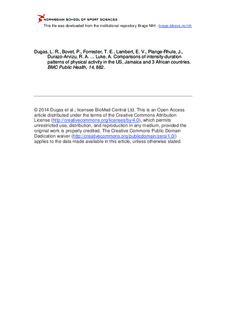| dc.description.abstract | This difference in how populations living in low-, middle or upper-income countries accumulate daily PA, i.e. patterns and intensity, is an important part in addressing the global PA movement. We sought to characterize objective PA in 2,500 participants spanning the epidemiologic transition. The Modeling the Epidemiologic Transition Study (METS) is a longitudinal study, in 5 countries. METS seeks to define the association between physical activity (PA), obesity and CVD risk in populations of African origin: Ghana (GH), South Africa (SA), Seychelles (SEY), Jamaica (JA) and the US (suburban Chicago).
Methods: Baseline measurements of objective PA, SES, anthropometrics and body composition, were completed on 2,500 men and women, aged 25–45 years. Moderate and vigorous PA (MVPA, min/d) on week and weekend days was explored ecologically, by adiposity status and manual labor.
Results: Among the men, obesity prevalence reflected the level of economic transition and was lowest in GH (1.7%) and SA (4.8%) and highest in the US (41%). SA (55%) and US (65%) women had the highest levels of obesity, compared to only 16% in GH. More men and women in developing countries engaged in manual labor and this was reflected by an almost doubling of measured MPVA among the men in GH (45 min/d) and SA (47 min/d) compared to only 28 min/d in the US. Women in GH (25 min/d), SA (21 min/d), JA (20 min/d) and SEY (20 min/d) accumulated significantly more MPVA than women in the US (14 min/d), yet this difference was not reflected by differences in BMI between SA, JA, SEY and US. Moderate PA constituted the bulk of the PA, with no study populations except SA men accumulating > 5 min/d of vigorous PA. Among the women, no sites accumulated >2 min/d of vigorous PA. Overweight/obese men were 22% less likely to engage in manual occupations.
Conclusion: While there is some association for PA with obesity, this relationship is inconsistent across the epidemiologic transition and suggests that PA policy recommendations should be tailored for each environment. | nb_NO |
